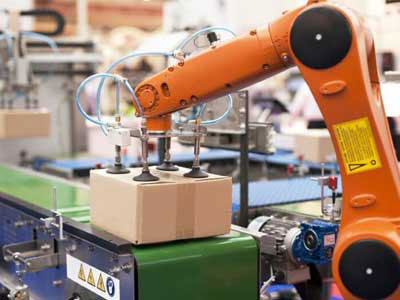Key Takeaway
Industrial robots use advanced sensors to enhance their functionality and efficiency. Proximity sensors detect nearby objects without physical contact, essential for obstacle and collision avoidance. Vision sensors enable robots to “see” and analyze their environment, improving precision in tasks. Force/torque sensors measure the forces applied by the robot, ensuring delicate handling of objects. LIDAR sensors map surroundings in 3D, aiding in navigation. These sensors collectively allow robots to operate autonomously, safely, and efficiently in industrial applications.
LiDAR and RADAR
LiDAR (Light Detection and Ranging) and RADAR (Radio Detection and Ranging) are both remote sensing technologies used for detection and ranging applications. LiDAR employs laser pulses to measure distances and create precise 3D maps of surroundings, commonly used in autonomous vehicles and environmental monitoring. RADAR, on the other hand, uses radio waves to detect objects and measure their speed and direction, crucial in aviation, weather forecasting, and military applications. Both technologies play key roles in enhancing safety and efficiency across various industries.

Advanced Vision Systems
Advanced vision systems form a crucial part of modern industrial robotics, relying on high-resolution cameras, sophisticated machine vision algorithms, and AI technologies. These components work together to interpret visual data, enabling robots to execute tasks that demand exceptional precision and detail. Applications include quality inspection, part identification, and pick-and-place operations. Imagine a robot on a manufacturing line; it uses its vision system to identify and remove defective products, ensuring only high-quality items proceed further. This level of precision dramatically improves product standards and reduces waste.
The integration of AI in these systems allows for real-time image processing and decision-making. This means that robots can adapt to changing environments swiftly and accurately. For example, if a new defect pattern emerges on a production line, the vision system can learn and adjust its inspection criteria on the fly. The continuous evolution of vision technology propels the advancement of smarter, more capable industrial robots, which can now perform a broader range of tasks with higher efficiency and accuracy. By continually improving these systems, industries can enhance productivity and maintain competitive edges in a fast-paced market.
Environmental Sensors
Environmental sensors are essential for monitoring and responding to changes in industrial surroundings. These sensors track parameters like temperature, humidity, pressure, and gas concentrations, which are critical for both machinery efficiency and worker safety. In an industrial setting, maintaining optimal environmental conditions can prevent equipment failures and ensure a safe working environment. For instance, temperature sensors can detect overheating in robotic systems, triggering automatic shutdowns or cooling mechanisms to prevent damage.
Gas sensors play a vital role in detecting hazardous leaks, prompting immediate safety protocols to protect human workers. This real-time monitoring helps maintain stable operating conditions, which is crucial for the longevity and reliability of industrial robots. By continuously collecting environmental data, these sensors enable proactive maintenance and timely interventions, reducing the risk of unexpected downtimes and enhancing overall system performance. This proactive approach ensures that both machinery and human operators are safeguarded, promoting a safer and more efficient industrial environment.
Haptic Sensors
Haptic sensors, also known as tactile sensors, equip robots with a sense of touch, measuring physical interactions like force, pressure, and texture. This capability is invaluable in industries requiring delicate handling, such as electronics and pharmaceuticals. For instance, in electronics manufacturing, haptic sensors allow robots to manage tiny, fragile components without causing damage. This precision ensures high-quality assembly and reduces material waste.
By mimicking human touch, haptic sensors enable robots to handle products with varying sensitivity levels, adapting to different materials and specifications dynamically. This adaptability is particularly useful in assembly lines where products can vary significantly. For example, a robot equipped with haptic sensors can shift from assembling delicate glass components to robust metal parts without compromising on precision or speed. This versatility makes haptic sensors indispensable for maintaining high productivity and quality in manufacturing processes, ensuring that products are assembled with the utmost care and accuracy.
Integrated Sensor Networks
Integrated sensor networks combine various sensor types into a unified system, providing a comprehensive view of the robot’s environment and operations. These networks facilitate real-time data collection and analysis, enhancing decision-making and process optimization. In such a network, data from LiDAR, RADAR, vision, environmental, and haptic sensors are aggregated and processed simultaneously. This holistic approach significantly improves the robot’s situational awareness and operational efficiency.
For instance, in a smart factory, an integrated sensor network can monitor production lines, detect anomalies, and optimize workflows, leading to increased productivity and reduced downtime. If a sensor detects an unusual temperature rise in a specific area, the system can alert maintenance crews and adjust the workflow to prevent potential failures. This real-time responsiveness ensures that the factory operates smoothly and efficiently, minimizing interruptions and maximizing output. By leveraging integrated sensor networks, industries can achieve higher levels of automation and control, paving the way for smarter, more efficient manufacturing processes.
Conclusion
Advanced sensors are revolutionizing industrial robotics, making them more intelligent, adaptive, and efficient. LiDAR and RADAR enhance navigation and obstacle detection, while advanced vision systems provide detailed visual insights. Environmental sensors ensure optimal operating conditions, and haptic sensors enable delicate handling tasks. Integrated sensor networks unify these capabilities, creating robust and versatile robotic systems.
For engineers entering the field, understanding these advanced sensors and their applications is crucial. These technologies not only improve robot performance but also pave the way for innovative solutions in industrial automation. By leveraging the power of advanced sensors, industries can achieve greater precision, efficiency, and safety in their operations.
